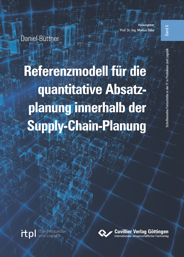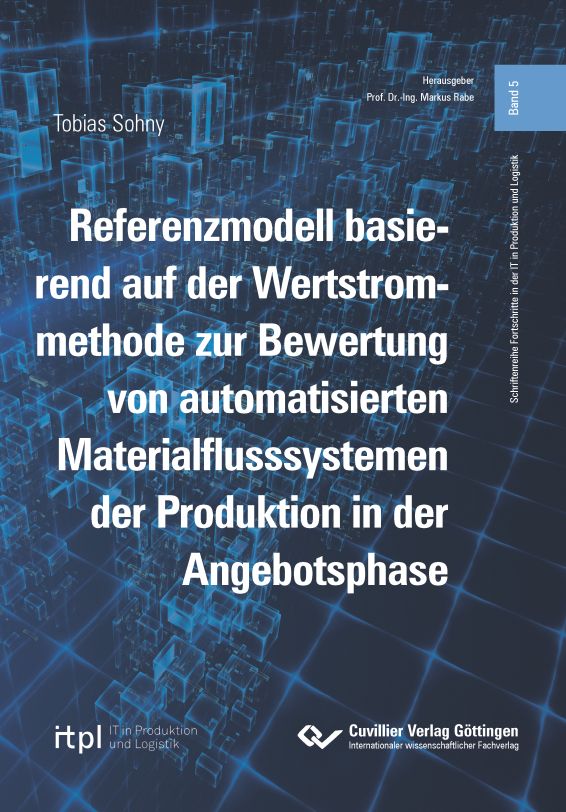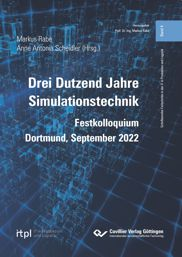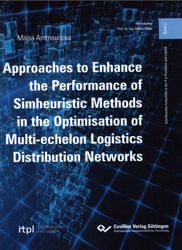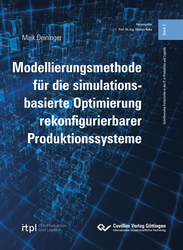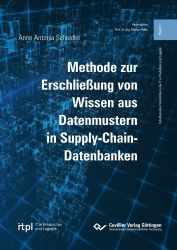Büttner, D.: A reference model for quantitative Sales Planning within Supply Chain Planning. Series "Fortschritte in der IT in Produktion und Logistik", Vol 6. Göttingen: Cuvillier 2023.
Manufacturing companies have to deal with a variety of challenges to supply consumers, such as high volatility in the sales market and global distribution networks. In the consumer goods industry, consumers determine the success of companies by purchasing products. To supply the sales market as quickly as possible, products have to be produced before demand arises and brought close to the consumer. Thus, these companies depend on forecasting future sales of their products in order to manage the supply chain according to the demand. The responsibility for creating forecast information, which is considered the basis for supply chain planning, lies with sales planning.
Currently, Sales planning makes inadequate use of data, even though academia has recommended basing decisions on the analysis of data for years. In addition, challenges such as insufficient skills, diversity of methods, and unclear processes inhibit the use of data and consequently quantitative methods.
This reference model for quantitative sales planning addresses these challenges and consolidates existing knowledge in the domain of sales planning. Thus, the reference model serves as a guide for the integration and improvement of quantitative sales planning in companies and facilitates access to knowledge. The model systematizes the planning process, forecasting methods - from naive methods to machine learning - and mandatory and optional forecast data within three maturity levels. The model reduces the effort to develop use case-specific sales planning, supports the generation of sales-related knowledge, and promotes the use of data for supply chain planning and as a result, the maintenance of competitiveness of the applying companies
Sohny, T.: Referenzmodell basierend auf der Wertstrommethode zur Bewertung von automatisierten Materialflusssystemen der Produktion in der Angebotsphase. Series "Fortschritte in der IT in Produktion und Logistik", Vol 5. Göttingen: Cuvillier 2023.
Automated material flow systems in production are highly dynamic and at the same time very complex. Suppliers have the challenge of guaranteeing a minimum throughput performance for such customised material flow systems when submitting their offer. Over-dimensioning, however, to ensure throughput, resulting in additional costs, leads to decreased competitive¬ness.
With simulation technology, executable models can represent dynamic and stochastic aspects of systems. Thus, alternatives can be evaluated. However, simulation is too time-consuming and cost-intensive at the time of the bidding phase. Therefore, it is regularly used only after an order has already been placed. Possible planning errors are recognised late and lead to cost-intensive adjustments.
In this work, a reference model based on the value stream method is developed, which contributes to a reduced modelling effort of simulation models for automated material flow systems at the time of the bidding phase. For efficient modelling, the user of the reference model has a construction scheme developed for this purpose, consisting of individual model elements with defined structures and relationships. Each model element represents a real system element of an automated material flow system with its characteristic properties, represented by system states, logic aspects, and attributes. The description of the system elements, with a suitable granularity for the bidding phase, is based on the value stream method, which is proven to be successful in the industrial environment, extended by the aspect of dynamics. The modular structure of the construction scheme and the description method allows for an application-specific parameterisation and the selection of specific model elements. The user is supported by a procedure for the specific use of the model elements, in a structured system analysis and the formal model description. With the execution of the modelling according to the reference model, the user receives a formalised model, which can be implemented simulator-specific in a simulation system without further explanation. This enables the supplier to secure his guaranteed throughput per offer in the shortest possible time and to increase his competitiveness by studying what-if scenarios.
The usability of the reference model is demonstrated by a simulation study of a real material flow system. It is shown that the given structure and the defined model elements support the designer in the system analysis and model formalisation in an application-specific way and, thus, reduce the modelling effort. The reliability and sufficiently accurate representation is proven by a phased verification and validation and the comparison with a detailed model.
Rabe, M.; Scheidler, A.-A. (eds.): Drei Dutzend Jahre Simulationstechnik - Festkolloquium September 2022. Göttingen: Cuvillier 2022.
Das Fachgebiet ITPL wurde zum Oktober 2010 neu an der TU Dortmund 2010 gegründet. Damit ist genau ein dutzend Betriebsjahre erreicht, und der Leiter des Fachgebietes kann vor dieser Periode auf exakt zwei weitere dutzend Jahre beim Fraunhofer-Institut in Berlin zurückblicken. Neun Weggefährten haben mit mir zurück und vorausgedacht und sind für ein Festkolloquium in Dortmund zusammengekommen. Die Zusammenfassungen der Kolloquiumsvorträge bilden diesen vierten Band unserer Fortschrittsberichte. Darüber hinaus haben die jungen Wissenschaftler, die am ITPL die Promotion anstreben und einen entsprechenden Forschungsstand aufweisen, ebenfalls ihr Vorhaben auf zwei Seiten für diesen Bericht zusammengefasst und auf dem Kolloquium in einem Science Slam präsentiert.
Fachlich decken die Vorträge einen weiten interdisziplinären Bereich ab, der seinen Fokus in der ereignisdiskreten Simulation findet und durch angrenzende Themen wie Visualisierung, Geschäftsprozessmanagement, Digitalisierung, maschinelles Lernen oder Referenzmodelle bereichert wird. Anwendungen adressieren beispielsweise Produktion und Produktions sowie Absatzplanung; Transportsysteme, Supply Chains und Distribution; sowie datengetriebene Prozesse beispielsweise für Qualitätssicherungsaufgaben, Nachverfolgbarkeit und Zuverlässigkeitsprognosen.
Ammouriova, M.: Approaches to Enhance the Performance of
Simheuristic Methods in the Optimisation of
Multi-echelon Logistics Distribution
Networks. Series "Fortschritte in der IT in Produktion und Logistik", Vol 3. Göttingen: Cuvillier 2021.
The management of logistics distribution networks is a challenging task. These networks consist of entities, such as stock keeping units (SKUs), and sites. Items are stored as SKUs in the sites and delivered to customers according to their placed orders. Decision-makers select actions, such as centralising an SKU in a site, to reduce costs and increase the service level. These actions might have a conflict impact on the costs and the service level, which triggers the complexity of the logistics distribution network. Moreover, the number of entities and the possible actions are influenced by the size of the networks. The selection of actions forms an NP-hard combinatorial optimisation problem. Thus, decision-makers utilise tools to assist them in selecting actions, such as a logistics assistance system (LAS).
Logistics assistance systems have been developed to recommend action plans to assist decision-makers. Action plans include actions to be applied on the network in a given order. These systems can be based on a simheuristic approach to benefit from the power of simulation and metaheuristics. In optimising logistics distribution networks, a metaheuristic algorithm is used to form action plans, and simulation is used to study the impact of these action plans on the costs and the service level. However, simulation is a computationally expensive tool because of the long simulation runs of large networks. Thus, the performance of a LAS is defined in terms of the impact of recommended action plans on a network with respect to the number of simulation runs needed to recommend action plans.
This research aims to propose approaches to enhance the performance of a LAS that is based on a simheuristics approach. The first approach utilises problem information called “domain-specific information” (DSI) to guide the search for promising actions, such as the type of changes applied by actions, the success of actions, and correlations between actions. According to the type of changes, actions are classified as structural actions and parametrical actions. Structural actions add entities or remove them from the network, while parametrical actions modify the entities’ parameters, such as the stock level of an SKU. The success of actions is defined based on the impact of the actions on the network. Relations between actions and their impact on the network define their correlations. The DSI approach alters the selection probabilities of actions to guide the metaheuristic algorithm in selecting promising actions.
The other two approaches aim to reduce the number of simulation runs. The first approach reduces the number of actions. Actions are grouped, and the grouped actions replace actions in the space of possible actions. The second approach defines conditions to skip simulation runs. In this approach, equivalent action plans are defined. Equivalent action plans have the same impact on the performance of the network.
The three approaches were evaluated on a logistics distribution network. The DSI approach found action plans with lower costs and a higher service level compared to a random selection of actions. Grouping actions formed a smaller space of actions that helped the LAS to recommend actions plans in a lower number of simulation runs. The last approach, defining equivalent action plans, helped to reduce the number of simulation runs. In conclusion, the evaluation showed that these approaches could be used to recommend promising action plans in a lower number of simulation runs.
Deininger, M.: Modellierungsmethode für die simulationsbasierte Optimierung rekonfigurierbarer Produktionssysteme. Series "Fortschritte in der IT in Produktion und Logistik", Vol 2. Göttingen: Cuvillier 2019.
Manufacturing companies today face many challenges. Competition, technological progress, and the changing expectations of customers result in a constantly changing environment. This leads to a con-tinuously changing product range, which is not only geared towards strategic realignment, but is also driven by customer demands. If a customer makes a request that does not correspond to the current product portfolio, decisions about the acceptance of the order must be made within a short time, often without a reliable forecast of their effects.
Simulation studies can be used to investigate potential changes to a production system before applying them in the real world. In particular, the stochastic behavior of processes in production systems, such as varying processing times, can be modeled and thus represent the actual behavior of the staff. How-ever, simulation is only able to evaluate a given system. Another aid to planning are optimization tech-niques. These allow for automated evaluation of various configurations of a system and providing a solution. The combination of simulation and optimization results in a method that supports a planner in the decision-making process, considering the stochastic influences.
In the present work, such a method is developed that enables the combination of simulation and opti-mization to determine which changes to a production system can be conducted to fulfill previously unachievable customer orders. These changes include, in the simplest case, the implementation of a new processing order for the customer orders. If this is not sufficient, it will be examined whether the addition of new resources enables the system to fulfill all customer orders. It is also possible to save or replace resources. Likewise, new processes can be added, e.g., for setup or qualification tasks.
The implementation of this procedure is carried out by a multi-level simulation-based optimization, which is based on modular modeling. Using modules, individual processes of the production system can be represented and linked together. Further, this approach allows for adding, removing, and exchang-ing processes. As part of an optimization, it is thus possible to determine a collection of processes that enables to fulfill all customer orders. In addition to processes, modules can also represent resources that can be used to determine the necessary resources in parallel to the processes. Each identified con-figuration undergoes job shop scheduling and is evaluated using simulation. After carrying out the simu-lation-based optimization, the planner receives a pareto diagram which contains all the solutions inves-tigated. From these, the solution to be implemented can finally be selected by the planner.
Two application examples demonstrate the applicability of the method. It is shown that every stage of simulation-based optimization helps to present a solution to the planner, with which all customer or-ders can be fulfilled. To do this, each level is considered and validated individually before considering their interaction.
Scheidler, A.A.: Methode zur Erschließung von Wissen aus Datenmustern in Supply-Chain-Datenbanken. Series "Fortschritte in der IT in Produktion und Logistik", Vol 1. Göttingen: Cuvillier 2017.
Ein elementarer Schritt zur Beherrschbarkeit der Supply Chain ist die Identifikation von Wirkzusammenhängen, die sich in den logistischen Transaktionen spiegeln. Aufgrund der unüberschaubaren Datenmenge kann die Entdeckung von komplexen Wirkzusammenhängen nicht manuell erfolgen. Die Dissertationsschrift stellt eine Methode zur Entdeckung von Wissen, wie beispielsweise den Wirkzusammenhängen, vor und diskutiert die Berücksichtigung von Kontextwissen in den einzelnen Vorgehensmodellphasen. Ein Schwerpunkt der entwickelten Methode ist die Integration einer modellbegleitenden Verifikation und Validierung in ein Vorgehensmodell der Wissensentdeckung. Durch einen neuartigen Einsatz der Simulation erweitert die Arbeit zudem die existierenden Verifikationsmöglichkeiten des Knowledge Discovery in Databases. Um einen Einsatz des Modells auch bei unzureichender Datenlage zu ermöglichen werden abschließend Konzepte des Data Farmings als Methodenelement eingeführt. Die praktische Anwendbarkeit der in dieser Arbeit entwickelten Methode wird anhand von Transaktionsdaten eines Elektronikkleingeräteherstellers sowie einem Data-Farming-Modell demonstriert.
